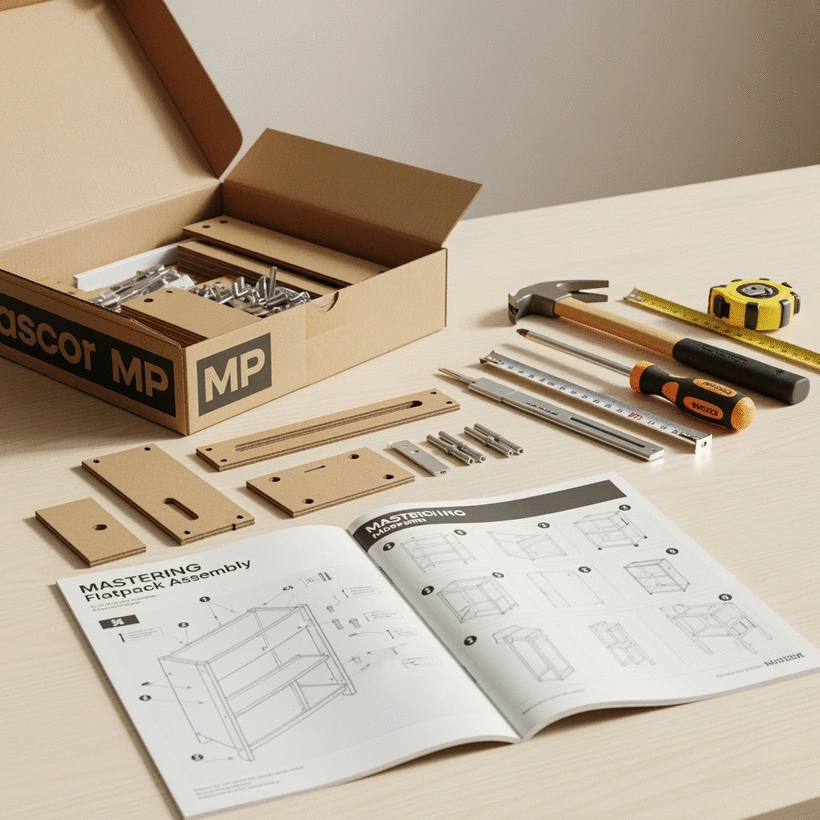Master Flatpack Assembly Without Errors

Have you ever found yourself staring at a pile of flatpack parts, feeling overwhelmed by the assembly process? You're not alone! Many DIY enthusiasts face similar challenges. This guide highlights common mistakes to avoid and strategies for a seamless assembly experience.
What You Will Learn
- Thoroughly reading the instructions can save time and prevent frustration during assembly.
- Organizing parts before starting helps to identify missing components and reduces confusion.
- Using the correct tools is crucial—having a reliable screwdriver and a level can make all the difference.
- Avoid over-tightening screws to maintain the integrity of the material and prevent damage.
- Precise measurements and alignment are essential for ensuring all pieces fit together correctly.
- Taking your time during assembly can lead to a more satisfying and successful outcome.
- Understanding how to properly use cam lock fasteners and dowels is key to a sturdy build.
Common Flatpack Assembly Pitfalls and Solutions
This visual outlines the most frequent mistakes made during flatpack assembly, alongside practical tips to avoid them, helping you achieve a smoother building experience. For more detailed advice on common issues, check out our guide on flat-pack furniture assembly tips.
Neglecting Instructions
Skipping the manual leads to errors. Read thoroughly to understand each step.
Disorganized Parts
Unsorted parts cause confusion. Lay out and check all components before starting.
Using Wrong Tools
Improper tools lead to damage. Use a reliable screwdriver, hammer, and level.
Over-Tightening Screws
Excessive force splits wood. Tighten snugly, not overly tight, to preserve integrity.
Ignoring Alignment
Misalignment compromises fit. Double-check measurements and alignment throughout.
Rushing Assembly
Haste makes waste. Take your time for perfect fitment and enjoyment.
Understanding Flatpack Assembly Challenges
As a DIY enthusiast, I know firsthand that assembling flatpack furniture can feel like an uphill battle! At Flatpack Hub, I aim to help you tackle these challenges head-on by shining a light on common mistakes and how to avoid them. So, let’s explore the most frequent assembly pitfalls you might encounter along the way.
Common Flatpack Assembly Mistakes to Avoid
When beginning your flatpack adventure, it's essential to be aware of the mistakes that can turn a simple assembly into a frustrating experience. Here are some of the most common errors I’ve seen and how you can save yourself from making them:
- Neglecting to Read Instructions Thoroughly: Skimming the manual is tempting, but each step is crucial for a successful assembly.
- Overlooking Parts Organization Before Assembly: Disorganized parts can add unnecessary stress and confusion.
- Using Incorrect Tools for the Job: Having the right tools makes all the difference—don’t underestimate this! You can find a comprehensive guide to essential tools for flat-pack furniture to help you get started.
- Over-Tightening Screws and Its Consequences: Too much pressure can damage the material, leading to weak joints.
- Ignoring Precise Measurements and Alignment: Accuracy is key; misalignments can cause major headaches.
- Rushing Through the Assembly Process: Taking your time ensures that every piece fits together perfectly.
- Common Errors with Cam Lock Fasteners and Dowels: Misusing these could lead to structural issues down the line.
Being aware of these mistakes is the first step toward a smoother assembly process. Remember, each mistake is a learning opportunity, and with practice, you’ll sharpen your flatpack skills!
Neglecting to Read Instructions Thoroughly
It might seem like a minor detail, but neglecting the instructions can set you up for failure. I get it; we all want to jump right in! However, I advise taking a moment to familiarize yourself with the assembly guide. Think of it as your roadmap—each part of the journey is important!
Overlooking Parts Organization Before Assembly
Let’s chat about organization. Before diving into assembly, lay out all your parts and pieces. A systematic approach makes it easier to identify any missing components. Plus, it saves time searching for that elusive screw halfway through your project!
Using Incorrect Tools for the Job
The right tools are your best friends in flatpack assembly! Using improper tools can lead to frustration and even damage to your furniture. Ensure you have a reliable Phillips screwdriver, a hammer, and a level handy. And if you’re feeling fancy, a multi-tool can be a game changer!
Over-Tightening Screws and Its Consequences
When it comes to tightening screws, less is often more. Over-tightening can cause wood to split or joints to weaken. Instead, aim for snug rather than tight—a delicate touch can go a long way in preserving the integrity of your furniture.
Ignoring Precise Measurements and Alignment
Precision is key in flatpack assembly! Ignoring measurements can lead to pieces that don’t fit together properly. Always double-check your alignment during assembly to avoid any misalignments that might disrupt the final look of your piece.
Rushing Through the Assembly Process
We all have busy lives, but rushing through the assembly process can lead to costly mistakes. Take your time to enjoy the project! Appreciate each step, and soon enough, you’ll have a beautifully assembled item you can be proud of.
Common Errors with Cam Lock Fasteners and Dowels
Lastly, let's not forget about cam lock fasteners and dowels. They are essential for a sturdy build, but improper installation can lead to instability. Pay close attention to how they should be inserted—you want a solid structure for your flatpack masterpiece!
Now that we've tackled these common mistakes, you're better equipped to handle your flatpack assembly with confidence! Stay tuned for the next section, where we’ll dive into preparation and planning for successful assembly. Happy building!
Pro Tip
Did you know? Taking a few moments to create a dedicated assembly space can significantly enhance your experience. Clear out a table or floor space, and make sure to have good lighting. This helps you see the details better and keeps your parts organized, reducing the likelihood of mistakes!
Recap of Tips for Avoiding Flatpack Assembly Mistakes
As we wrap up our discussion on avoiding common flatpack assembly mistakes, it's crucial to emphasize preparation and execution. A clear understanding of the steps to take can make all the difference in your assembly experience! Remember, a smooth assembly process starts long before you even open the box.
- Read the instructions thoroughly: Familiarizing yourself with the guide first can save you time and headaches.
- Organize parts: Lay everything out to keep track of what's what.
- Gather essential tools: Make sure you have the right tools ready before you start.
- Take your time: Rushing can lead to mistakes that end up costing more time in the long run.
Implementing these strategies will not only enhance your flatpack assembly experience but also create a sense of accomplishment as you see your furniture come together flawlessly.
Summarizing Key Preparation and Execution Strategies
To recap, here are some key strategies for successful flatpack assembly:
- Understand the instructions: Take a moment to read through the entire manual.
- Prepare your workspace: A clean and organized area makes assembly easier.
- Check all parts: Ensure you have every piece before starting.
- Follow a methodical approach: Don’t skip steps, and double-check alignment.
By honing these techniques, you'll be setting yourself up for success. As someone who's tackled numerous flatpack projects, I can assure you that these strategies work wonders!
Visual Aids and Resources for Better Understanding
Sometimes, a little visual help goes a long way in understanding assembly processes. There are plenty of online resources where you can find videos and diagrams that illustrate assembly techniques.
- YouTube tutorials: Many DIY enthusiasts share their assembly experiences, which can provide helpful tips.
- Brand-specific guides: Some furniture brands offer online video support tailored to their products.
- DIY blogs: Websites like Flatpack Hub are a treasure trove of tips specifically designed for flatpack furniture enthusiasts!
Utilizing these resources can turn a potentially frustrating assembly into a fun and engaging activity.
Using Printable Assembly Checklists for Better Organization
One of my favorite tools for staying organized during flatpack assembly is a printable checklist. Having a visual guide helps keep track of parts and steps while ensuring you don't overlook anything. You can create your own checklist or find numerous templates online tailored for various furniture brands.
- Parts checklist: List all parts to verify you have everything before starting.
- Step-by-step guide: Break down the assembly process into manageable parts.
- Tools checklist: Ensure you have all necessary tools handy.
Using checklists not only enhances your organization but also boosts your confidence as you progress through the assembly process!
Next Steps: Troubleshooting and Further Assistance
Now that you’re equipped with tips to avoid common assembly mistakes, let’s look at the next steps you can take for further assistance.
Printable Quick-Reference Guides for Assembly
For those moments when you need a quick reminder or troubleshooting assistance, printable quick-reference guides can be invaluable. These guides often include:
- Common troubleshooting tips.
- Quick fixes for assembly problems.
- Visual guides for alignment and measurements.
Having these resources on hand can make your flatpack assembly process smoother and more enjoyable!
Engaging with User-Generated Tips and Community Resources
Don't forget to tap into the collective knowledge of fellow DIY enthusiasts! Engaging with community resources can provide fresh insights and tips that are specifically tailored to your assembly challenges.
- Online forums: Join discussions on platforms like Reddit or specialized DIY forums.
- Social media groups: Find Facebook groups dedicated to flatpack furniture enthusiasts.
- Local workshops: Attend DIY workshops where you can learn from others and share experiences.
Exploring these community resources not only enhances your skills but also connects you with others who share your passion for DIY projects!
Exploring Sustainability in Flatpack Furniture Choices
As you consider your next flatpack assembly project, think about sustainability. There are many brands that prioritize eco-friendly materials and practices. Choosing sustainable options not only benefits the environment but can also enhance the quality of your furniture.
Understanding Furniture Maintenance and Quality Control
Lastly, as you assemble your flatpack furniture, take a moment to learn about the maintenance needs and quality control of your chosen pieces. Understanding how to care for your furniture helps ensure it lasts for years to come!
Frequently Asked Questions (FAQs)
- Q1: Why is reading instructions thoroughly so important for flatpack assembly?
- A1: Reading instructions thoroughly is crucial because it acts as your roadmap, preventing errors and ensuring you understand each step, which saves time and frustration in the long run.
- Q2: What are the benefits of organizing parts before starting assembly?
- A2: Organizing parts helps you easily identify any missing components, reduces confusion, and makes the assembly process more efficient, saving time and stress.
- Q3: What tools are essential for flatpack assembly, and why are they important?
- A3: Essential tools include a reliable Phillips screwdriver, a hammer, and a level. Using the correct tools prevents damage to the furniture and ensures a proper, sturdy build.
- Q4: How can I avoid over-tightening screws in flatpack furniture?
- A4: To avoid over-tightening, aim for a snug fit rather than an overly tight one. Excessive force can split wood or weaken joints, so a delicate touch is recommended to preserve material integrity.
- Q5: Why is precision and alignment critical during the assembly process?
- A5: Precision and alignment are key to ensuring all pieces fit together correctly. Ignoring measurements or misalignments can compromise the structural integrity and final appearance of your furniture.
Recap of Key Points
Here is a quick recap of the important points discussed in the article:
- Read the instructions thoroughly: Familiarizing yourself with the guide first can save you time and headaches.
- Organize parts: Lay everything out to keep track of what's what.
- Gather essential tools: Make sure you have the right tools ready before you start.
- Take your time: Rushing can lead to mistakes that end up costing more time in the long run.
- Check for precise measurements and alignment: Ensure everything fits together perfectly to avoid misalignments.
- Avoid over-tightening screws: Less is often more; ensure a snug fit without damaging the material.









